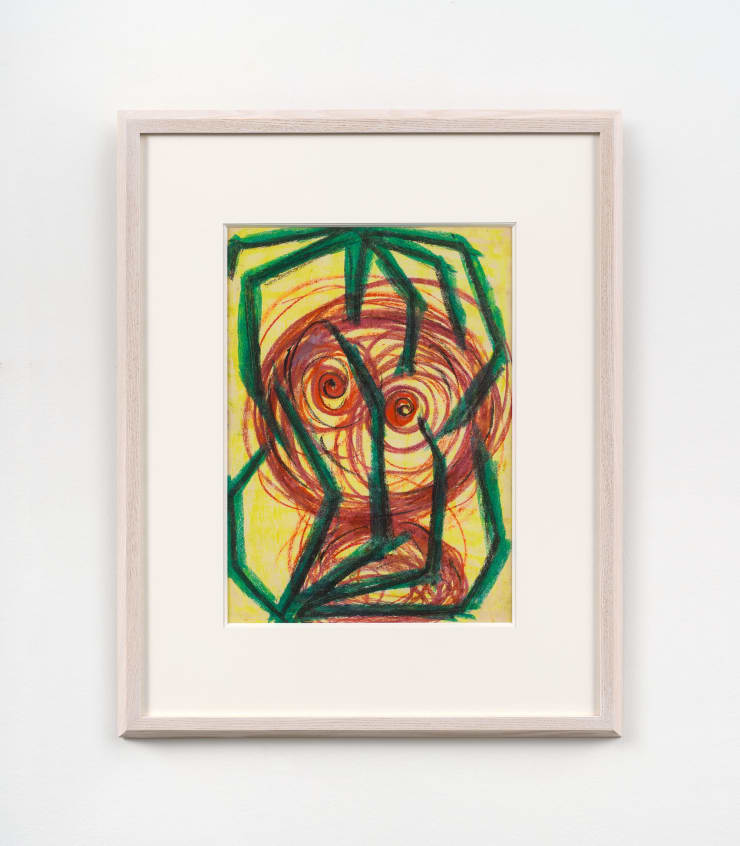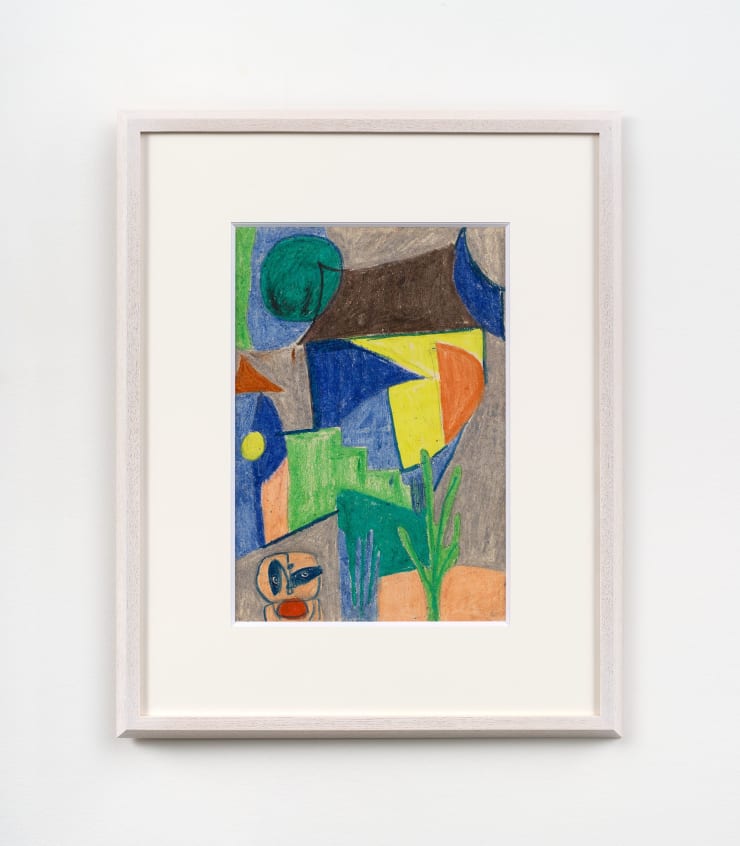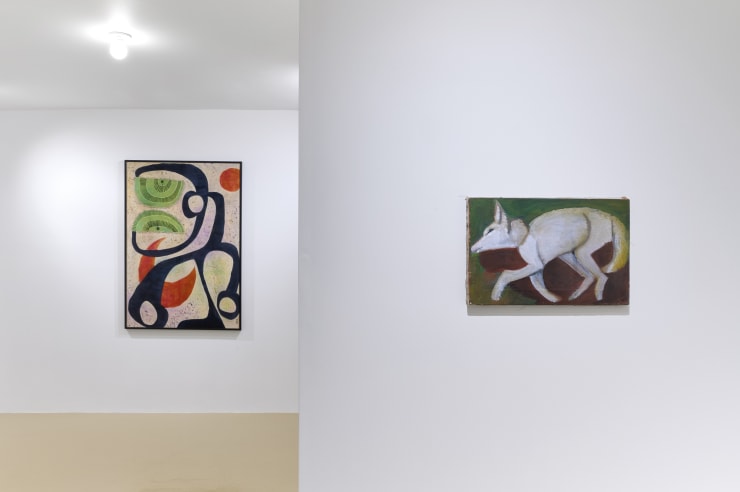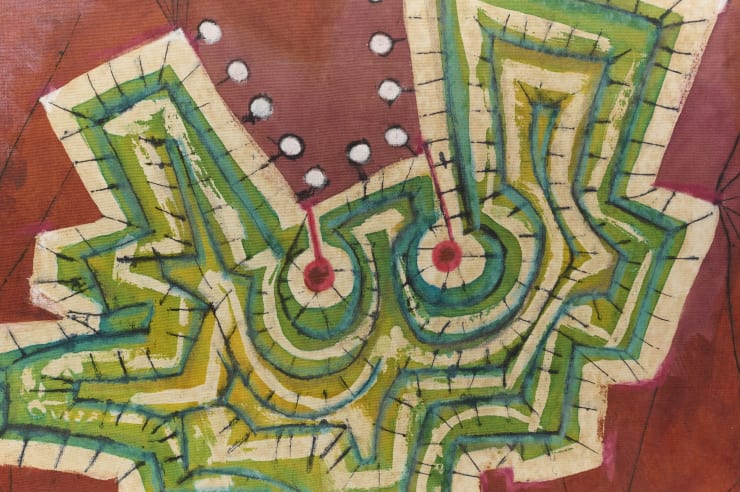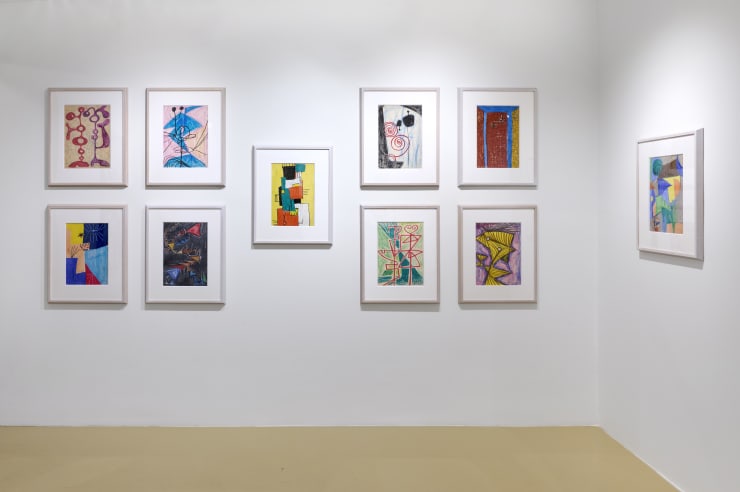SAORI (MADOKORO) AKUTAGAWA : CENTENARIA
Opening reception: Saturday, February 24, 2024, 4 – 8pm
Venue: 6917 Melrose Ave. Los Angeles, CA 90038
Nonaka-Hill is pleased to present Saori (Madokoro) Akutagawa (1924 – 1966), a Centennial celebration of the artist’s birth, marking her first solo exhibition in the United States, spanning an extensive and multi-faceted career from 1955 - 1966. The exhibition opens February 24th and will be on view through April 20, 2024. An opening reception will be held for the artist on Saturday, February 24, from 4-8 pm.
Trained in the arts, initially in music and vocals, in post-war Tokyo, Saori (Madokoro) Akutagawa turned her focus to painting, drawing and batik practices in the early 1950s. Making her first professional appearance as an artist in 1954 at the 6th Japan Independent Exhibition; a year later Akutagawa was feted with the newcomer award at Nika Association and effectively launched publicly, a rare and rapid rise for a woman even in burgeoning egalitarian post-war Japan. 1945 – 1955 saw radical and broad changes not just for women overall, but also for aspiring artists, as educational opportunities improved and non-membership, non-juried exhibitions were initiated by flourishing media conglomerates who sponsored and reviewed these presentations. Akutagawa was singled out among both critics and influential artists - Shuzo Takiguchi, Taro Okamoto, Art Life Magazine among others - throughout her career, and was the subject of several posthumous exhibitions and articles in Japan, upon her untimely death in 1966.
I had a really good dream. It was New Year’s. There was a ship about to set sail from a port. I was on board. My heart was bouncing up and down, burning with hope.
February 1954
Social, political and economic shifts in Japan during Akutagawa’s tenure as an artist made for dramatic effect on women (who received the right to vote in 1947) and paved the way for this married, mother of two, to forge an independent orbit that proved dynamic amongst those of her contemporaries. Akutagawa travelled extensively with her composer husband early in their marriage, even venturing to off-limits Russia, where she would surely have witnessed first-hand the state-sponsored social realist activities of her artist peers. In 1955, The Mexican Art Exhibition at Tokyo National Museum generated mounting interest among artists and the public alike, and initiated what was referred to as “Mexico Boom” for the illustrious political and nationalist muralists Rivera, Siqueiros and Orozco, yet it was Rufino Tamayo who became especially influential on Akutagawa. Rufino and Akutagawa shared a keen interest in European modernist models as formed by Cubism, Dada and Surrealism and both drew liberally on their own country’s folklore and myth, historic symbolism and iconography. While Akutagawa trained in batik practice with Michikata Noguchi, the impact of Tamayo - now seen in person, and studied eagerly in publications – cemented a visual language dense with demonstrative graphic gestures and a fierce palette coupled with a commitment to traditional craft and experimental, unconventional techniques. Akutagawa’s international dialogue had begun in earnest at the studio.
I don’t care about technique. What matters more is the thing that breaks the rules and floods the image. Whatever happens, I’m going to make my personality come alive on the canvas. There’s no need to try to make something complete. I want it to be fierce. Intense. I want it to burn!
April 1954
In 1959 Akutagawa (who had separated from her husband and children) arrived in Los Angeles and enrolled in graphic design classes at Art Center (1956 saw the External Trade Recovery Organization supporting Japanese students at Art Center). What would the artist have encountered upon arrival? Would Akutagawa have visited Virginia Dwan gallery in Westwood before it moved east to New York? Could she have been curious about Ferus Gallery with its roster of pre-pop artists who rejected the drama and inner reach of Abstract Expressionism to explore more conceptual, performative interests? She traveled to New York the following year and studied oil painting at the Art Students League with Will Barnet, participating (under her maiden name Saori Yamada) in the 14th Women Artist Association Japan-U.S. Exchange Exhibition at Riverside Museum with Yuki Katsura, Takaei Murao, and Yayoi Kusama. Enthused by this new chapter, Akutagawa (as she was still known, despite remarrying architect Yukio Madokoro – a collaborator of Isamu Noguchi) now embraced abstract oil painting, reducing her biomorphic narratives into increasingly geometric compositions, using a minimal palette reminiscent of Russian Constructivist interests from a decade earlier and curiously in step with the movements from a former influential teacher (and champion of Mono-ha students) Yoshishige Saitō. In 1962 Akutagawa returned to Japan where she continued to work and exhibit this new body of work extensively until her death four years later.
What is art, I wonder? Why do I draw and paint? Sometimes questions like these overtake me.
November 1953
The exhibition at Nonaka-Hill features several of the artist’s signature vivid drawings, late painting and unique dyed linens spanning the decade Akutagawa devoted herself to exercising, exhibiting and traveling as an artist. Recognized initially for her “Woman” series, it is curious to consider if, as in Rufino and Picasso, Akutagawa was paying attention to the 1950’s notoriety Willem de Kooning was earning for on the same subject. Akutagawa’s emotive, active, radically rendered women – conceptual, characterized – exude a profound insight that moves beyond per scripted formalism. The same can be said of her Kojiki (Japanese ancient chronicle) animated figures in landscapes and later minimalist abstractions. The late paintings to which she was firmly committed, present silhouettes that strain together to generate a tension of push-pull, an active figure ground exchange that aligns more demonstratively with the time-based actions of her contemporaries Yoko Ono, Yayoi Kusama and Atsuko Tanaka.
Saori (Madokoro) Akutagawa is held in the following public collections:
Itabashi Art Museum
Kariya City Art Museum
M+ Hong Kong
Museum of Contemporary Art Tokyo
Nagoya City Art Museum
National Museum of Modern Art Tokyo
Setagaya Art Museum
Takamatsu Art Museum
Taro Okamoto Museum of Art Kawasaki
Tochigi Prefectural Museum of Fine Arts
Toyohashi City Museum of Art and History
Yokosuka Museum of Art
Nonaka-Hill is indebted to the collaboration of the artist’s family in realizing this exhibition.
SAORI (MADOKORO) AKUTAGAWA
CENTENARIA
February 24 – April 20, 2024
Venue: 6917 Melrose Ave. Los Angeles, CA 90038
 Saori (Madokoro) AkutagawaTwo Women III, 1955Dyed linen51 1/8 x 35 in (130 x 89 cm)
Saori (Madokoro) AkutagawaTwo Women III, 1955Dyed linen51 1/8 x 35 in (130 x 89 cm)
52 1/4 x 36 1/4 x 1 1/2 in framed (132.7 x 92.1 x 3.8 cm framed) Saori (Madokoro) AkutagawaWomen XII, 1955Dyed linen51 1/8 x 35 in (130 x 89 cm)
Saori (Madokoro) AkutagawaWomen XII, 1955Dyed linen51 1/8 x 35 in (130 x 89 cm)
52 1/4 x 36 1/4 x 1 1/2 in framed (132.7 x 92.1 x 3.8 cm framed) Saori (Madokoro) AkutagawaScarlet and Gray 朱とグレー, 1963Oil on canvas51 3/8 x 35 1/4 in (130.5 x 89.5 cm)
Saori (Madokoro) AkutagawaScarlet and Gray 朱とグレー, 1963Oil on canvas51 3/8 x 35 1/4 in (130.5 x 89.5 cm)
52 3/8 x 36 1/4 in framed (133 x 92.1 cm framed) Saori (Madokoro) AkutagawaUntitled, 1962Oil on canvas35 1/4 x 51 3/8 in (89.5 x 130.5 cm)
Saori (Madokoro) AkutagawaUntitled, 1962Oil on canvas35 1/4 x 51 3/8 in (89.5 x 130.5 cm)
36 1/4 x 52 3/8 in framed (92.1 x 133 cm framed) Saori (Madokoro) AkutagawaUntitledOil on canvas20 7/8 x 17 7/8 in
Saori (Madokoro) AkutagawaUntitledOil on canvas20 7/8 x 17 7/8 in
53 x 45.5 cm Saori (Madokoro) AkutagawaUntitledOil on canvas10 3/4 x 16 1/8 in
Saori (Madokoro) AkutagawaUntitledOil on canvas10 3/4 x 16 1/8 in
27.2 x 41 cm Saori (Madokoro) AkutagawaUntitled (C-10/15)Oil pastel on paper14 3/8 x 10 in
Saori (Madokoro) AkutagawaUntitled (C-10/15)Oil pastel on paper14 3/8 x 10 in
36.4 x 25.4 cm Saori (Madokoro) AkutagawaUntitled (B-7/21)Oil pastel on paper14 3/8 x 10 3/8 in
Saori (Madokoro) AkutagawaUntitled (B-7/21)Oil pastel on paper14 3/8 x 10 3/8 in
36.5 x 26.4 cm Saori (Madokoro) AkutagawaUntitled (B-10/21)Oil pastel on paper13 5/8 x 9 5/8 in
Saori (Madokoro) AkutagawaUntitled (B-10/21)Oil pastel on paper13 5/8 x 9 5/8 in
34.5 x 24.5 cm Saori (Madokoro) AkutagawaUntitled (H-1/27)Oil pastel on paper14 1/4 x 10 3/8 in
Saori (Madokoro) AkutagawaUntitled (H-1/27)Oil pastel on paper14 1/4 x 10 3/8 in
36.3 x 26.4 cm Saori (Madokoro) AkutagawaUntitled (J-33/42)Oil pastel on paper13 5/8 x 9 5/8 in
Saori (Madokoro) AkutagawaUntitled (J-33/42)Oil pastel on paper13 5/8 x 9 5/8 in
34.5 x 24.5 cm Saori (Madokoro) AkutagawaUntitled (H-19/27)Oil pastel on paper14 1/4 x 10 3/8 in
Saori (Madokoro) AkutagawaUntitled (H-19/27)Oil pastel on paper14 1/4 x 10 3/8 in
36.3 x 26.3 cm Saori (Madokoro) AkutagawaUntitled (F-22/24)Oil pastel on paper14 1/8 x 9 3/4 in
Saori (Madokoro) AkutagawaUntitled (F-22/24)Oil pastel on paper14 1/8 x 9 3/4 in
36 x 24.6 cm Saori (Madokoro) AkutagawaUntitled (D-15/25)Oil pastel on paper14 x 9 5/8 in
Saori (Madokoro) AkutagawaUntitled (D-15/25)Oil pastel on paper14 x 9 5/8 in
35.6 x 24.5 cm Saori (Madokoro) AkutagawaUntitled (D-12/25)Oil pastel on paper14 x 9 7/8 in
Saori (Madokoro) AkutagawaUntitled (D-12/25)Oil pastel on paper14 x 9 7/8 in
35.6 x 25.2 cm Saori (Madokoro) AkutagawaUntitled (D-11/25)Oil pastel on paper13 5/8 x 9 5/8 in
Saori (Madokoro) AkutagawaUntitled (D-11/25)Oil pastel on paper13 5/8 x 9 5/8 in
34.5 x 24.5 cm Saori (Madokoro) AkutagawaUntitled (E-5/11)Oil pastel on paper14 1/4 x 9 7/8 in
Saori (Madokoro) AkutagawaUntitled (E-5/11)Oil pastel on paper14 1/4 x 9 7/8 in
36.3 x 25.1 cm Saori (Madokoro) AkutagawaUntitled (J-40/42)Oil pastel on paper14 1/4 x 10 3/8 in
Saori (Madokoro) AkutagawaUntitled (J-40/42)Oil pastel on paper14 1/4 x 10 3/8 in
36.1 x 26.3 cm
Related artist
Artist Exhibited:
Ulala Imai
Kazuo Kadonaga
Kentaro Kawabata
Zenzaburo Kojima
Kisho Kurokawa
Tadaaki Kuwayama
Toshio Matsumoto
Keita Matsunaga
Yutaka Matsuzawa
Kimiyo Mishima
Kunié Sugiura
Takuro Tamayama
Tiger Tateishi
Sofu Teshigahara
Shomei Tomatsu
Wataru Tominaga
Hosai Matsubayashi XVI
Kansuke Yamamoto
Masaomi Yasunaga
Exhibitions:
-2025-
Sea of Mud, Wall of Flame: Satoru Hoshino and Masaomi Ysunaga
KEY HIRAGA: The Elegant Life of Mr. H
-2024-
KYOKO IDETSU: What can an ideology do for me?
KENTARO KAWABATA / BRUCE NAUMAN
SAORI (MADOKORO) AKUTAGAWA: CENTENARIA
Keita Matsunaga : Accumulation Flow
-2023-
NONAKA-HILL ♥ TATAMI ANTIQUES: A holiday sale of unique objects from Japan
TAKASHI HOMMA : REVOLUTION No.9 / Camera Obscura Studies
TATSUMI HIJIKATA THE LAST BUTOH: Photographs by Yasuo Kuroda
Kiyomizu Rokubey VIII: CERAMIC SIGHT
Masaomi Yasunaga: 石拾いからの発見 / discoveries from picking up stones
SHUZO AZUCHI GULLIVER ‘Synogenesis’
Koichi Enomoto: Against the day
Tatsuo Ikeda / Michael E. Smith
Hiroshi Sugito: the garden with Zenzaburo Kojima
Zenzaburo Kojima: This very green
Tomohisa Obana: To see the rainbow at night, I must make it myself
Daisuke Fukunaga: Beautiful Work
- 2021 -
Natsuyasumi: In the Beginning Was Love
Takashi Homma: mushrooms from the forest
– 2020 –
Hosai Matsubayashi XVI & Trevor Shimizu
Sterling Ruby and Masaomi Yasunaga
– 2019 –
A show about an architectural monograph
Yutaka Matsuzawa
Yutaka Matsuzawa through the lens of Mitsutoshi Hanaga
Takuro Tamayama & Tiger Tateishi
Kunié Sugiura
Masaomi Yasunaga
Miho Dohi
Wataru Tominaga
Naotaka Hiro
Parergon: Japanese Art of the 1980s and 1990s
Tadaaki Kuwayama
– 2018 –
Toshio Matsumoto
Kentaro Kawabata
Kansuke Yamamoto
Kazuo Kadonaga: Wood / Paper / Bamboo / Glass
Press:
-2025-
OCULA, Kaoru Ueda
Galerie, Kaoru Ueda
Ceramic Now, Satoru Hoshino and Masaomi Yasunaga
ARTFORUM, Sawako Goda
Artillery Magazine, Sawako Goda
-2024-
Artsy, Nonaka-Hill
Richesse, Nonaka-Hill Kyoto
Bijutsutecho, Nonaka-Hill Kyoto
The Art Newspaper, Nonaka-Hill Kyoto
Meer, Kyoko Idetsu
Bijyutsutecho, Masaomi Yasunaga
Switch, Masaomi Yasunaga
ARTnews JAPAN, Masaomi Yasunaga
Richesse, Masaomi Yasunaga
Art Basel, Daisuke Fukunaga, Imai Ulala
Art Basel, Kazuo Kadonaga, Sofu Teshigahara
-2023-
ADF webmagazine, Yasuo Kuroda, Tatsumi Hijikata
e-flux, Sanya Kantarofsky, Yasuo Kuroda
Los Angeles Times, Kenzi Shiokava
Artillery, Masaomi Yasunaga
Contemporary Art Daily Shuzo Azuchi Gulliver
- 2022 -
Contemporary Art Daily, Tomohisa Obana
ARTE FUSE, Daisuke Fukunaga
Contemporary Art Daily, Daisuke Fukunaga
Contemporary Art Review Los Angeles (Carla), Daisuke Fukunaga
What's on Los Angeles, Daisuke Fukunaga
Hyperallergic, Daisuke Fukunaga
Artillery, Kentaro Kawabata
Larchmont Buzz, entaro Kawabata
- 2021 -
Art Viewer, Natsuyasumi: In the Beginning Was Love
Hyperallergic, Natsuyasumi: In the Beginning Was Love
Art Viewer, Takashi Homma
Hyperallergic, Busy Work at Home
Art Viewer, Busy Work at Home
Hyperallergic, Ulala Imai
Contemporary Art Review Los Angeles (Carla), Ulala Imai
Contemporary Art Daily, Ulala Imai
artillery, Ulala Imai
Special Ops, Ulala Imai
Art Viewer, Ulala Imai
artillery, Matsubayashi & Trevor Shimizu
– 2020 –
Ceramic Now, Sterling Ryby and Masaomi Yasunaga
Hypebeast, Sterling Ryby and Masaomi Yasunaga
Art Viewer, Sterling Ruby and Masaomi Yasunaga
Air Mail, Sterling Ruby and Masaomi Yasunaga
Los Angeles Times, Kaz Oshiro
ArtnowLA, Kaz Oshiro
What's on Los Angeles, Kaz Oshiro
KCRW, Kaz Oshiro
Tique, Kaz Oshiro
Contemporary Art Daily, Kaz Oshiro
Art Viewer, Kaz Oshiro
Contemporary Art Daily, Sofu Teshigahara
Art Viewer, Sofu Teshigahara
KCRW, Sofu Tsshigahara
Hyperallergic, Nonaka-Hill
Los Angeles Times, Keita Matsunaga
– 2019 –
Los Angeles Times, Tatsumi Hijikata
Art Viewer, Tatsumi Hijikata, Eikoh Hosoe
Contemporary Art Review Los Angeles, Tatsumi Hijikata, Eikoh Hosoe
ArtAsiaPacific, Yutaka Matsuzawa
Los Angeles Times, Tatsumi Hijikata
AUTRE, Tatsumi Hijikata, Eikoh Hosoe
Los Angeles Times, Nonaka-Hill
ARTFORUM, Takuro Tamayama, Tiger Tateishi
Art Viewer, Takuro Tamayama, Tiger Tateishi
KCRW, Nonaka-Hill
LA WEEKLY, Nonaka-Hill
AUTRE, Takuro Tamayama, Tiger Tateishi
ArtsuZe, Takuro Tamayama, Tiger Tateishi
ARTFORUM, Review: Tadaaki Kuwayama, Rakuko Naito
Art Viewer, Masaomi Yasunaga, Kunié Sugiura
Los Angeles Times, Masaomi Yasunaga
KQED, Tadaaki Kuwayama, Rakuko Naito
Contemporary Art Daily, Naotaka Hiro, Wataru Tominaga, Miho Dohi
Los Angeles Times, Miho Dohi
Los Angeles Review of Books, Miho Dohi
Bijutsu Techo, Naotaka Hiro, Wataru Tominaga, Miho Dohi
Art Viewer, Miho Dohi
Art & Object, Parergon
COOL HUNTING, Felix Art Fair
Art Viewer, Tadaaki Kuwayama
artnet news, Nonaka-Hill
Contemporary Art Review Los Angeles (Carla), Tadaaki Kuwayama
– 2018 –
Art Viewer, Kentaro Kawabata
Contemporary Art Daily, Kazuo kadonaga
Los Angeles Times, Kazuo Kadonaga
ARTFORUM, Kazuo Kadonaga
Contemporary Art Daily, Shomei Tomatsu
KCRW, Kimiyo Mishima, Shomei Tomatsu
This website uses cookies
This site uses cookies to help make it more useful to you. Find out more about cookies.









